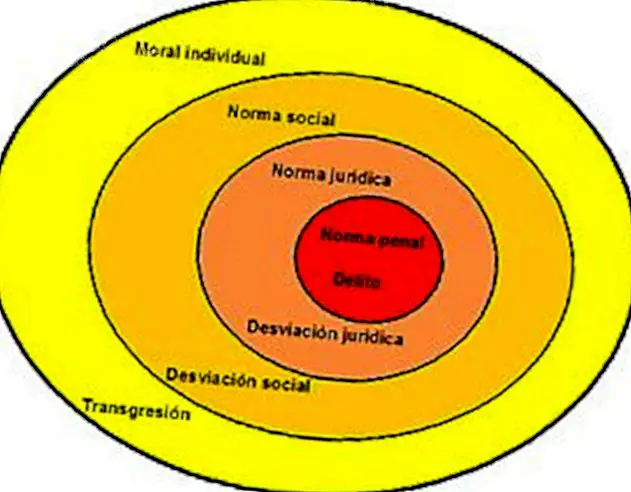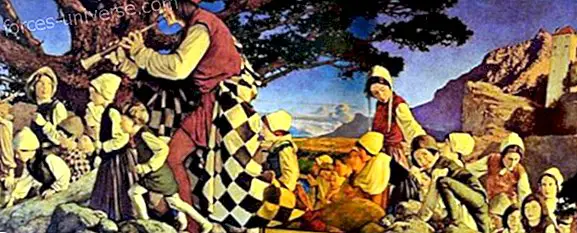 “Share some moral minimums
“Share some moral minimums
from which it is possible to build together
a more just society, and respect,
that each one defends and persecutes
his ideals of happiness ”
Adela Cortina
Although all human beings seek to obtain the greatest amount of satisfaction from the surrounding environment, there is, beyond human will, a series of universal rules, a series of principles that regulate human activities, we call these the Laws Divine, or Divine Will.
On an individual level, each person seeks to obtain the greatest number of satisfiers of the relationships they have with other human beings. At the collective level, there is the natural inclination by divine law, to reach a state of harmonic equilibrium among all the members of an ecological community.
Free will has to be understood as a prerogative of man to be able to self-direct his actions, up to a certain point that does not oblige the divine laws that seek balance between all the members, to act. When this occurs, it means that the human being has broken the balance by using his free will and nature begins to act accordingly to restore it, even this, despite the will of man. The human being uses his free will without taking into account the implications of his conduct, this can be done to a point where he obliges other higher laws to act and then he himself must seek a readjustment of his interests in favor of the community.
On a psychological level, human beings go through the same lessons, each individual seeks to exercise his will within the relationships he has with other people, often seeking selfish gain; This may be done until as long as their selfishness does not cause a violent response from the rest of the people, when this occurs, it means that the balance has been broken and a struggle of forces begins, where the community will necessarily predominate over the interests of An individual, in this case, the free will of this person must submit to the will of society.
The problem arises when the formal education of the members of a social system increases, when the technology that they must master to perform the assigned tasks increases and when the variety of demands to which they must respond increases. It is necessary then to establish universal minimum values that make social coexistence and diverse lifestyles viable. These minimum values would be constituted by Human Rights.
THE SOCIAL SYSTEM AND ITS INTERNAL DYNAMICS
While a community is a group of people living together, an organization is an intentional system that contains at least two intentional elements with a common purpose, for which the system has a functional division of labor.
Families, organizations and nations are social systems with the following characteristics:
1. These are types of democratic organization in which each individual who receives the influence of what that organization does has a decision-making capacity regarding what it does.
2. They have an internal economy in which each party can buy the goods and / or services that it requires from any internal or external source that it chooses.
3. They have a multidimensional organizational structure.
4. They use interactive planning, which implies the idealized redesign of the organization.
5. They contain a decision support system that facilitates learning and adaptation.
Social Management System
The social system that pursues an ideal state must have a management system that has the capacity to learn how to adapt and how to learn. The administration is the one that controls an intentional system and performs a part of it. The administration is the one that observes the behavior of the Organization (A) and the environment (B). When observing, it generates data (1) that requires processing to convert it into information (2). Information processing is the function of the information subsystem (C). It consists of three subsystems for:
- The making of technical and strategic decisions. Role of the Board of Directors. Planning
- The identification of real and potential problems. Role of a Coordinating Council. Metacognition.
- The maintenance and improvement of performance under variable and invariable conditions. Function of the Operational Council. Creativity.
The Management subsystem (D) makes decisions based on information that may be biased and originated in automatic thoughts. The record of these decisions must be kept in a memory (E), where the real conditions are compared with the ideals and the actual results with the expected ones, information that will be used to give instructions (7). The defined goals (8) and the actual performance of that decision must be compared. Biases (9) are also used for the Coordinator subsystem (F) to perform the ethical judgment. The objective of a diagnosis is to determine what caused the deviations and to prescribe a corrective or exploitation action. Although the causes of confirmatory biases can be difficult to identify, there are only four types.
- The information used to make the decision was incorrect. Which requires a change in the cognitive subsystem (10a) or in the consciousness subsystem (10d) in order to avoid the repetition of the error.
- The decision-making process may have been wrong. This requires a change in the subsystem of will. (10b).
- The decision may not have been implemented as planned. What requires changes (10c).
- The medium can change in a way that was not anticipated. In such cases, a way must be found to better anticipate these changes, decrease sensitivity to them, or reduce the likelihood of their occurrence.
The process that begins with the preparation of a record of decisions (6) and that concludes with a change of mentality or environment (10) is what makes it possible for the mind to learn and adapt in a meaningful and effective way. The changes ensure double circuit learning and adaptation: learning how to learn and how to adapt.
Some of these performance indicators (11) are symptoms, which should be interpreted by the operating subsystem (G) as a symbol system. The intelligences have to self-evaluate the way to capitalize their resources (12). These strengths and weaknesses should be diagnosed. Once a diagnosis is obtained, the threats or opportunities detected (13) must be reported to the management subsystem. The coordinating subsystem must distribute a diagnostic and prescription record (14) very similar to the decision record.
The Fields and States of the I.
The human being has three fields from where he establishes his relations with other human beings and with the same: The "social field" where he intersperses with the rest of humanity. His “living space” where he rests, feels free, considers himself an owner and allows access to only a few people. And finally what we call the "intimate field", which manifests itself particularly in states of deep crisis, where the human being faces himself and fights for his survival.
We could say that at the social field level, the human being acts through the formal and family education he has received, it is the field of conventions, it is the field where the rules of society govern.
The living space on the other hand, is a psychological field where the most intimate needs and desires of being prevail, is a field where the rules of society do not work, is the field where only the voice of being speaks and already They have no influence neither their education, nor their parents, nor the people who directed their education, although it should be noted that this vital space during the stage of its construction, was definitely formed taking into account all the factors that he received during his psychological training. It can be said that narrow vital fields are typical of people with great self-confidence, high personal esteem; Wide vital fields are characteristic of fearful people and full of psychological pathologies.
There is a third field even more intimate than the vital space, it is the one in which the person faces himself in his most intimate conflicts; other people do not come into play there, it is the conflict of their personality with their spiritual essence, it is the conflict suffered by depressive people, for example, or people who are about to commit suicide; these conflicts are of another order and are generally stopped by that last field that the human being maintains in the most intimate part of his being, to this field we could call the field of the psyche of the self.
Any social transaction or interaction between people, gives rise to an exchange of caresses; Each word that is crossed is nothing more than a sway of energies, where both people can be enriched, or they can be offended and damaged.
The offenses are born of the inability that each human being has to understand others in their permanent search for caresses, the offenses serve only, either to claim a right that is not had, or as a method to achieve some reaction that in Your poor opinion may represent a caress.
By analyzing transactions between people we can realize how we all rival to attract attention. A person can behave as a child, parent or adult, following the way in which the parents transmitted their authority.
The state of the parent self is characteristic of critical, rigid, judgmental or excessively protective or auxiliary people. The state of the child I is characteristic of those circumstances in which it is manipulated from a position of weakness, guilt or irresponsibility. Finally, the state of the adult self is typical of maturity, when capacities are used to gather information from a number of sources, consider options and make decisions based on current information.
 THE SOCIAL CONSCIENCE: between customs and laws.
THE SOCIAL CONSCIENCE: between customs and laws.
All human beings are born free and equal
in dignity and rights and, gifted as they are
of reason and conscience, they must behave
fraternally with each other.
The human being has struggled to move from the animal kingdom to the human kingdom, has made use of his instinct which is both the cause and the effect of his actions. From instinct, desire is born.
While the arbitration refers to the action, the will refers to the foundation of the action and is identified with practical reason. The discretion that can be determined by pure (intuition) reason is called free will. The freedom of arbitration is the independence of its determination by sensitive impulses. The pure reason is that which provides the laws for freedom, these laws of freedom are called morals.
The concordance or discrepancy of an action with the law, without taking into account the motives of the same, is called legality, but when the motive of the action is taken into account as a duty it is called ethicity. The maxim is the subjective principle to act, which the subject himself takes as a rule, while the principle of duty is what reason absolutely sends him. It is the reason that links the legal effect with the action and moral conscience makes court, moral personality that makes the law effective.
| NATURAL LAWS | MORAL LAWS | SPIRITUAL LAWS |
| Wish Competitiveness Selfishness Instinct Conflict Diversity Anarchy Sex | Freedom Solidarity Empathy Intellect Conciliation Correlation Leadership Fusion | Will |
It is difficult to make clear distinctions between established customs and laws. Customs are budding laws and police regulations. If they have been in force for a long time, undefined customs tend to crystallize into precise laws, concrete regulations and well-defined social conventions.
IDENTITY-BELONGING, UNITY IN DIVERSITY.
Identity is an encounter with oneself that demands the full development of personality and its fusion with character. Identification is the reflection of our divine part in our human part. Will, conscience and intelligence are the divine aspects that are reflected in the thinking, feeling and acting of a person.
Nationality is the legal link that a citizen establishes with the State.
Belonging is the cognitive-affective link that a person establishes with the environment and the city both in relation to physical spaces and the communities that live there; link to be characterized by being aware, critical, inclusive, responsible and participatory. A competent citizen who is strongly linked to his environment is one who:
? Build your identity respecting the differences between the different identities of the members of the community of which you are a part and of other communities.
? It is committed to the construction and compliance with rules and agreements, recognizes its importance for the construction of citizenship and peaceful coexistence.
? He is interested in acting for the care and well-being of his community and the spaces it inhabits.
Diversity manifests itself in the originality and plurality of the identities that characterize the groups and societies that make up humanity.
 LEADERSHIP AND PARTICIPATION
LEADERSHIP AND PARTICIPATION
The feelings, attitudes, orientation and practices of social leaders are inspired by the following democratic principles.
1. The conviction of the inherent value, integrity and dignity of the individual.
2. The conviction that the individual has the right to determine for himself what his needs are and how they should be treated.
3. The firm belief of equal opportunities for all, limited only by innate individual abilities.
4. The conviction that individual rights are related to their social responsibilities to themselves, their family and their society.
Leadership styles:
In the authoritarian style the leader makes all decisions and seeks obedience in his followers, determines the policy to follow and assumes responsibility for all actions. This style is the most desirable in situations where time is the most important factor and therefore lends itself to situations that require speed.
The democratic style is characteristic of the leader who is considered moderator when drawing ideas and suggestions from the group. His main techniques are discussion and consultation. Each member is involved in the action of the group. In many cases, this type of leadership favors the creativity and personal satisfaction of each individual.
In the permissive style the leader is a kind of information center, his role is less prominent than in the other styles and the control he exercises is minimal
The organizational climate:
When applying the concepts of atmosphere and climate to organizations, reference is made to the emotional state of their members, and to the way in which the internal environment and the communication style are affected.
Participation:
Participation is one of the mechanisms of democracy that generates greater personal and social autonomy, and that modifies power relations. The essence of democracy is the absence of a last authority, which is called the circularity of power. Democracy requires that anyone who has authority over others be subject to their collective authority. The central idea in the notion of circular organization is that each person who occupies a position of authority has a board of directors.
The councils normally assume the following responsibilities:
1. The planning.
2. The definition of policies for the management unit.
3. Coordination and integration of plans and policies.
4. Decision making that affects the quality of work life.
5. Performance evaluation.
THE SOCIAL SERVICE IN HEALTH AND EDUCATION
Within the framework of the basic values that have been exposed, the social service tries to assist individuals, groups and communities to reach the highest possible level of social, mental and physical well-being. The goals of social service are to reconcile the well-being of individuals with the well-being of the society in which they live, as well as to promote, prevent and address the harmful psychosocial effects of crisis situations.
Based on the knowledge of the elements that determine human behavior, the social service tries to develop in the individual, all the constructive forces that allow them to build a fuller and more satisfying life for themselves.
The encounter between health and education is oriented towards the promotion of healthy lifestyles, in the search for integral well-being through responsible, informed and autonomous decision-making in the face of the dilemmas and challenges proposed by daily life.
Healthy lifestyles are those critical and assertive ways of being and acting, which allow the preservation and promotion of one's own freedom and that of other people, based on autonomous, informed and responsible decision making; These decisions are guided by respect for the dignity inherent in every human being in ways that contribute to their self-realization.
Promotion:
In general, promotion is understood as the execution of actions that cause something to happen: to promote is the action of mobilizing the social collective towards the achievement of a higher level purpose.
It can also be understood as the action of promoting, fostering and energizing towards the development of something. The promotion focuses on the development of citizen competencies and the exercise of human rights, determines the quality of the organizational climate and defines the criteria of coexistence.
Prevention:
Prevention is understood as the preparation and provision that is made in advance to avoid a risk. It is considered that prevention seeks to intervene in a timely manner in dynamics and behaviors that could affect the exercise of human rights and coexistence. That is, you will carry out prevention actions by identifying and intervening on factors that motivate the occurrence of events or that may facilitate their repetition.
This is how prevention actions intervene on factors or situations that threaten the exercise of human rights, so that episodes of violation (violence, discrimination, inequality, harassment, aggression, censorship, authoritarianism, etc.) do not escalate and repeat until they become relational dynamics within the community. The above, to prevent them from configuring the identity of the people who make up the educational community or being part of the characterization of the context.
Attention:
It refers to attending, paying attention with special care. The attention component guides all those actions that are carried out to timely and pedagogically assist the people who make up the organization, in the face of situations that affect coexistence and the exercise of human rights.
It means that the School Coexistence Law requires that a pedagogical perspective be applied in the management of situations that affect school life. What is a pedagogical perspective with special care? It is to promote the reconstruction of the situation in an environment of dialogue, respect, care and recognition of the people involved. It means generating options to restore the state of things, it means mitigating the nonconformities or damages that result from the situation.
Attending is to solve through the management of the situation, facilitate scenarios and actions where the organization can respond proactively to situations that affect coexistence, participation and relationships between the people who make up the organization. These actions can be pedagogical, didactic and normative.
The attention is usually framed on the immediate: it always seems urgent to give a quick solution to situations that affect living together. The consequence of this attitude is that the required time is not dedicated to the proper handling of the situation.
Contrary to this, a pedagogical attention with special care will investigate what happened with the people involved and establish a solution that recomposes the situation in circumstances that leave people satisfied, so that repetition and escalation of the situation is avoided.
A genuine pedagogical attention recognizes the value of the actions of all people, fully identifies the characteristics of situations that affect coexistence, proposes dialogue-mediation scenarios, and generates actions that allow affected people to inform and report; protecting your integrity and confidentiality.
Type I situation. Inappropriate managed conflicts and those sporadic situations that negatively affect the organizational climate correspond to this type, and that in no case generate damage to the body or physical or mental health.
When conflicts are not resolved constructively, they can lead to events that affect coexistence such as altercations, confrontations or quarrels between two or more people in the community. These situations can occur in the daily development of the activities, in the hours of rest, in the meetings, etc.
Type II situations. This type corresponds to situations of aggression, harassment and cyberbullying, which do not present the characteristics of the commission of a crime and that comply with any of the following particularities:
a) That they are presented repeatedly or systematically.
b) That they cause damage to the body or health (physical or mental) without generating any disability for any of the people involved.
For the attention of these situations the action of the organization and in some cases of other entities is required, for example, in cases of affectation to the body or physical or mental health of the people involved or when necessary rights restoration measures.
Type III situations. This type corresponds to situations of aggression that are constitutive of alleged crimes against freedom, integrity and sexual training, or that constitute any other crime established in the current criminal law.
They require that care be provided by entities outside the organization (for example, Children and Adolescents, Family, health sector, etc.).
The ethical minimums of society


 LEADERSHIP AND PARTICIPATION
LEADERSHIP AND PARTICIPATION 




